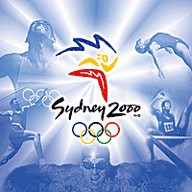Jason Maloney reviews
Eidos
- Price: £29.99
- Players: 1-8
- System Requirements : (recom.)
- Windows 95/98
- Pentium III or equivalent
- 64Mb RAM
- 3D accelerated graphics card – 16 bit colour, 16Mb RAM
- DirectX 7.0a compliant sound and graphics cards Click HERE to read DVDfever Dom‘s review of the Dreamcast version.

Sydney 2000 arrives right on time to tie-in with the Olympics currently taking place Down Under. Eidos have succeeded where both EA Sports and Empire Interactive failed miserably this summer (with Euro 2000 and International Cricket Captain 2000 respectively), by producing not only a top-quality in-depth simulation but also managing to release it simultaneously on the three major formats – PC, Playstation and Dreamcast.
This game is nothing if not comprehensive. A pleasing attention to detail, coupled with a welcome non-Arcade alternative option, gives Sydney 2000 a playability beyond the likes of Konami’s seminal Track & Field series.
Having said that, if simply competing in a quick-fire competition against either human or computer opponents is all that’s required, Sydney 2000 delivers that with a gaming style pretty much identical to Track & Field‘s two-button-pounding control system. While this is hardly original, it’s easy to pick up for beginners and instantly familiar to everyone else.
No fewer than 12 events are featured –
- 100m Sprint: Virtually the same as the Track & Field staple, needing only frenetic button/key pressing for around 10-15 seconds (or less if you’re good). Dipping for the finish line using a designated Action key is a nice added touch.
110m Hurdles: As above, with the addition of Action key-hitting to clear the hurdles.
High Jump: Another familiar event, and slightly easier to master than the Konami equivalent.
Triple Jump: Once you’ve come to grips with getting the right projection for each of three movements using the Action key, there are few problems. The replay feature looks especially good for this, utilising the superior graphics and multiple camera angles.
Hammer: My personal lack of co-ordination always makes this one tough, but the upside of that is I get to hear the witticisms of the commentary team as they ridicule my pathetic attempts. I always did prefer the Shot Putt….
Javelin: Always fairly simple to get the hang of, this follows the Track & Field blueprint down to the last detail (except, of course, for the omission of that annoying Japanese computer voice reading out the score)
100m Freestyle Swimming: Surprisingly good renderings of the swimmers (including the pre-race rituals) make for dynamic gameplay. The replays show the action form several angles, including underwater. Lovely.
10m Platform Diving: This is where Sydney 2000 comes into its own, with the first (and best) of five exclusive events. Platform Diving is as much fun in training or solo as in competition. That armstand reverse dive with 4.5 somersault and 1.5 twist (in the piked position) will soon be second nature. The early qualifying rounds offer some amusement, as hopeless entrants completely fluff their dives. And you won’t want to miss the replays of your brilliant exploits.
Kayak K1 Slalom: Recalls childhood memories of Superstars (late 70s and early 80s TV show that pitted famous sportspersons against each other in a kind of Decathlon). Manoeuvre through raging white-waters and negotiate the necessary markers and gates. If you can.
Super Heavyweight Weight Lifting: These guys are ugly… really ugly… and that’s before they grunt and grimace under several hundred kilos. Despite using the same two-buttons-plus-action-key method, the result is remarkably realistic and playable.
Olympic Sprint Cycling: A head-to-head relay race in which success relies on the abiltity to conserve energy during the opening stages, as well as a smooth peel-off at the end of each lap (by using the Action key).
Skeet Shooting: A rather bizarre one, this. Burly men with dodgy moustaches and wellies fire at moving pieces of clay. A lot. The competition seems to go on for ever. Probably because I’m no good at it.
Many of these events actually have their own designated controller settings, all of which are provided both in the game’s menu and also its accompanying instruction manual.
Where the game really excels is in Olympic Mode. Building up strength, skills and morale through a careful series of assigned Gym Exercises which get progressively tougher, you train for a round of Qualifying tournaments in the hope of making the Olympic team in each of the 12 sports for your chosen nation. It’s the section most likely to bear repeated gaming, and by far the most rewarding. Performance improves quite visibly as each training session is successfully negotiated.
The commentary is limited, but effective in small doses. If you choose to view the efforts of all your opponents (computer or otherwise), most phrases soon become repetitive.
While this is nothing particularly new as such, Sydney 2000 is a well-timed and hugely enjoyable experience. One criticism is the fixed gender for the athletes in each sport. Runners are always male, while water events are exclusively performed by females. An option to choose which sex you would prefer to compete as (and therefore with) would make the game even better.
SOUND EFFECTS AND MUSIC
PLAYABILITY
ORIGINALITY
ENJOYMENT





















 OVERALL
OVERALL 




Check out Jason’s homepage: The Slipstream.
Reviewer of movies, videogames and music since 1994. Aortic valve operation survivor from the same year. Running DVDfever.co.uk since 2000. Nobel Peace Prize winner 2021.
